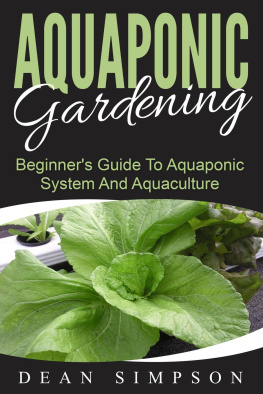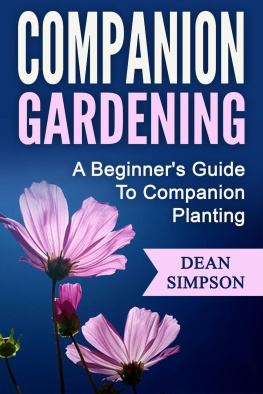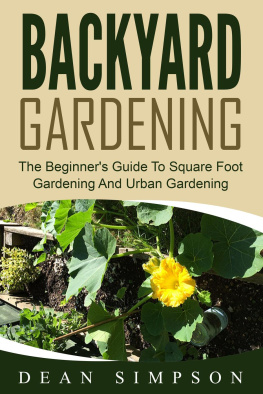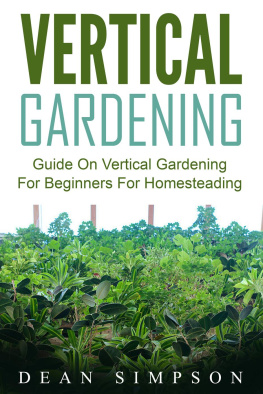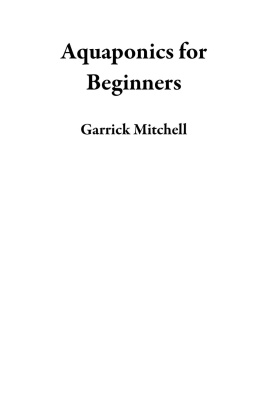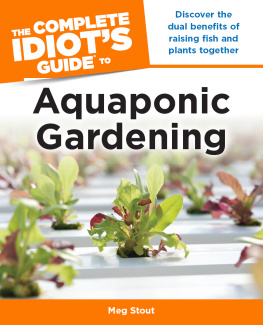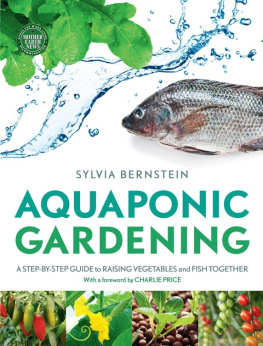Dean Simpson - Aquaponic Gardening: Beginners Guide To Aquaponic System And Aquaculture
Here you can read online Dean Simpson - Aquaponic Gardening: Beginners Guide To Aquaponic System And Aquaculture full text of the book (entire story) in english for free. Download pdf and epub, get meaning, cover and reviews about this ebook. year: 2017, publisher: Dean Simpson, genre: Children. Description of the work, (preface) as well as reviews are available. Best literature library LitArk.com created for fans of good reading and offers a wide selection of genres:
Romance novel
Science fiction
Adventure
Detective
Science
History
Home and family
Prose
Art
Politics
Computer
Non-fiction
Religion
Business
Children
Humor
Choose a favorite category and find really read worthwhile books. Enjoy immersion in the world of imagination, feel the emotions of the characters or learn something new for yourself, make an fascinating discovery.
- Book:Aquaponic Gardening: Beginners Guide To Aquaponic System And Aquaculture
- Author:
- Publisher:Dean Simpson
- Genre:
- Year:2017
- Rating:3 / 5
- Favourites:Add to favourites
- Your mark:
- 60
- 1
- 2
- 3
- 4
- 5
Aquaponic Gardening: Beginners Guide To Aquaponic System And Aquaculture: summary, description and annotation
We offer to read an annotation, description, summary or preface (depends on what the author of the book "Aquaponic Gardening: Beginners Guide To Aquaponic System And Aquaculture" wrote himself). If you haven't found the necessary information about the book — write in the comments, we will try to find it.
The perfect aquaponic gardening guide is necessary while designing your garden. There are many who don't realize the importance of getting things right and it starts here with a robust gardening handbook.
Dean Simpson has years of experience with aquaponics and will be able to guide you through the process.
Enjoy this gardening guide and make full use of it!
Dean Simpson: author's other books
Who wrote Aquaponic Gardening: Beginners Guide To Aquaponic System And Aquaculture? Find out the surname, the name of the author of the book and a list of all author's works by series.
Aquaponic Gardening: Beginners Guide To Aquaponic System And Aquaculture — read online for free the complete book (whole text) full work
Below is the text of the book, divided by pages. System saving the place of the last page read, allows you to conveniently read the book "Aquaponic Gardening: Beginners Guide To Aquaponic System And Aquaculture" online for free, without having to search again every time where you left off. Put a bookmark, and you can go to the page where you finished reading at any time.
Font size:
Interval:
Bookmark:
While every precaution has been taken in the preparation of this book, the publisher assumes no responsibility for errors or omissions, or for damages resulting from the use of the information contained herein.
AQUAPONIC GARDENING: BEGINNER'S GUIDE TO AQUAPONIC SYSTEM AND AQUACULTURE
First edition. March 31, 2017.
Copyright 2017 Dean Simpson.
Written by Dean Simpson.
10 9 8 7 6 5 4 3 2 1
Aquaponics Gardening Guide
I n the Aquaponic system, this side effect is easily neutralized by the use of a symbiotic process. All the water from the aquaculture system is continuously fed into a hydroponic system. The constituents of the hydroponics system use the by-products and are broken down by the nitrification bacteria in nitrites and nitrates. These components are essential to the growth of plants so the plants use them as nutrients and the water is then gets circulated back in the aquaculture system.
It is a symbiotic production of vegetables and fish. The metabolites produced by the fish have to be treated using bacteria. Post treatment they can be spread over the grow beds. The plants in the bed can utilize these nutrients for their growth. This technique is a boon for places that do not have unlimited access to land and water. According to data collected over various systems, aquaponics uses only one per cent of freshwater that is used by conventional agriculture but it has the potential of producing three to six times the output that would have been produced by conventional farming methods.
I have covered all the important aspects of Aquaponics through the course of this book. I want to thank you for choosing this book. Hope you find it informative.
Aquaponics is not a new concept. It has been around since ancient times. However, the exact place of origin is a topic that is constantly under debate. The Aztecs were among the earliest recorded practitioners of aquaponics. They had small islands called Chinampas. They were little cultivated agricultural islands. These islands were set up in lake shallows and similar places where they could be easily irrigated. The waste materials from the cities were rerouted to these islands. This system might be considered as a parent system to the actual aquaponics system because it is still unclear how they reared fish. In Indonesia, Thailand and South China, the farmers were able to rear fish in a paddy field and they managed to cultivate rice. This system was very widespread in the Far East. They were quite proficient in rearing snails and fish like swamp eel, common carp, oriental loach and crucian carp. In light of these techniques, China has now resorted to huge floating ploycultural fish farms and aquaponics systems.
M odern aquaponics is mostly the result of the dedicated efforts of the New Alchemy Institute and the North Carolina State University. The first attempt at aquaponics research in Canada was the addition of a small system into the existing aquaculture research that was being conducted in Lethbridge, Alberta. Through the nineties, there was a massive rise in this culture throughout Canada as the crop became more profitable. The main things they grew were trout and lettuce.
T he system is basically comprised of two parts. One part is responsible for the rearing and feeding of aquatic animals while the hydroponics part is the backbone for growing plants. Although the basic working may seem simple enough at first sight it has the potential to escalate and get out of hand if not monitored carefully. For example, the metabolites released by the fish can bring down the system if not controlled properly. So there are lots of subsystems at work here taking care of things like solid waste removal, acid neutralizing and maintaining the required oxygen levels. These abiotic components of the system may be grouped broadly into the following components.
I t is the primary tank for the rearing and feeding of fish.
Settling basin
This basins primary function is to collect all the particles of food and waste that settle down. They can also be used to effectively remove fine particulates.
T his is one of the most important components of the system that is responsible for maintaining a much-needed balance in the aquaponics system. It can be considered a breeding ground for the bacteria that is responsible for nitrification.
T his is the most vital component for the plant cultivation part of the system. This setup is singularly responsible for absorbing all the excess nutrients from the water.
T he sump is the lowest point in the entire system. This is where the water flows. From here it gets pumped back into the rearing tanks.
These components are not exclusive to a specific type of aquaponics system but they are a basic, integral part of any aquaponics system. In some of the more sophisticated commercial systems, they may have done away with a couple of these components by replacing them with a single unit.
T he living things in an aquaponics system comprises of plants, fishes and bacteria.
T he plant compatibility with an aquaponics system is very diverse but it also depends on various factors like stocking density and maturity of fish. This is a very important factor because it is pivotal in making sure that the effluents are taken to the bacteria in the right amounts. Green, leafy vegetables with a low or medium nutrition content are a great choice for this system. Some of the most common examples include lettuce, spinach, basil, herbs and Chinese cabbage. Vegetables with a high nutrient content require systems that have a higher stocking density and hence require a lot more attention. The salad friendly vegetables can be cultivated very easily in aquaponics systems. Some of the most profitable choices for an aquaponics system would be vegetables like lettuce, basil, tomato, roses and Chinese cabbage.
F reshwater fish are the most obvious choice for the aquaponics system. There is a specialized branch that raises saltwater fish as well. Tilapia is the most commonly used type of fish because it can serve both commercial and domestic purposes. They are a warm water species and so they do not have a lot of trouble adjusting to sudden changes in temperature or concentration of nutrients. Other popular species of fish include silver perch, barramundi, catfish and Murray cod. When there isnt an ability or need of maintaining a particular temperature for the water, species like bluegill and catfish are used. This also makes them very apt for domestic systems. All these species have one thing in common. They are all edible. So if you are not looking at raising the fish for profit then you could go in for the Koi and goldfish varieties.
O ne of the most important processes of any aquaponics system is nitrification. Nitrification is the conversion of ammonia into nitrates. This is very essential as it significantly reduces the toxicity levels of the water making it safer for the fish. The nitrates that are not filtered out are used by the plants for their photosynthesis. Ammonia is constantly released into the system by the fish. It spreads into the water through the gills and excreta of the fish. This ammonia has to be filtered out effectively because above a certain level it is very harmful for the fish. Plants are capable of assimilating ammonia from the water. However, they are much more open to absorbing nitrates because they are easier to break down. Ammonia can be converted into other useful products of nitrogen through Nitrosomonas and Nitrobacter . The former is responsible for converting ammonia to nitrites while the latter is responsible for converting nitrites into nitrates.
Font size:
Interval:
Bookmark:
Similar books «Aquaponic Gardening: Beginners Guide To Aquaponic System And Aquaculture»
Look at similar books to Aquaponic Gardening: Beginners Guide To Aquaponic System And Aquaculture. We have selected literature similar in name and meaning in the hope of providing readers with more options to find new, interesting, not yet read works.
Discussion, reviews of the book Aquaponic Gardening: Beginners Guide To Aquaponic System And Aquaculture and just readers' own opinions. Leave your comments, write what you think about the work, its meaning or the main characters. Specify what exactly you liked and what you didn't like, and why you think so.

